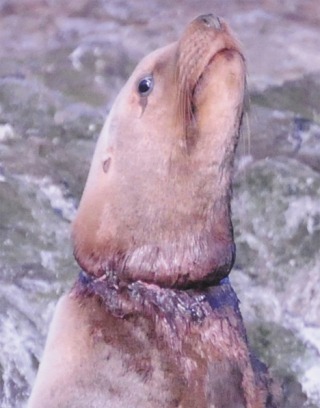A local whale watch operator photographed a Steller sea lion on Whale Rocks last week with some type of plastic embedded in its neck, according to the San Juan County Marine Mammal Stranding Network.
Jim Maya reported the finding to Amy Traxler, Stranding Network coordinator.
The sea lion appears to be in relatively good condition, Traxler said, but the Network is working on contingency plans in case the animal’s condition worsens and it comes ashore in a place where it can be restrained and treated.
“It is not unheard of for plastic straps to fray and eventually break, but often these can restrict the throat area enough to debilitate or even kill the animal,” said Joe Gaydos, Stranding Network veterinarian and regional director of the SeaDoc Society.
Traxler said she receives an average of three to four calls a year about marine wildlife entangled in plastic or fishing gear.
“We have had reports of plastic entanglement on free-swimming animals, but have never been able to accurately document these cases because the animals never came ashore,” she said.
Of the sea lion, Traxler said, “We’d certainly like to help this little guy out if we can.”
If you see this entangled sea lion or any other marine mammal that is stranded, dead or alive, report it to the Stranding Hotline, (800) 562-8832); or call Traxler directly at 472-1852.
Traxler and Gaydos wrote in a press release about the danger that plastic debris poses to marine life:
Plastic debris has invaded the planet — both land and sea. In even the most remote spots, you can find plastic water bottles, disposable diapers, and 6-pack holders.
Plastics get into our waters through storm drain systems, by being dumped directly into the ocean by recreational and commercial boaters, or by being left on the beach by beach-goers.
Although some of this “marine debris” eventually washes ashore, much of it stays in the open ocean where it can pose severe hazards to all types of marine life.




